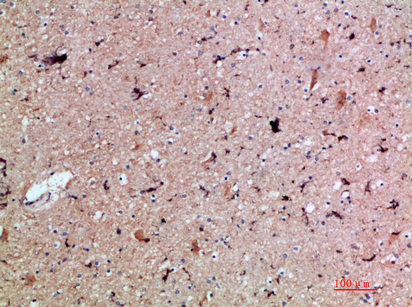PBP Polyclonal Antibody
- Catalog No.:YT5963
- Applications:IHC;IF;ELISA
- Reactivity:Human
- Target:
- PBP
- Fields:
- >>Cytokine-cytokine receptor interaction;>>Viral protein interaction with cytokine and cytokine receptor;>>Chemokine signaling pathway
- Gene Name:
- PPBP CTAP3 CXCL7 SCYB7 TGB1 THBGB1
- Protein Name:
- Platelet basic protein (PBP) (C-X-C motif chemokine 7) (Leukocyte-derived growth factor) (LDGF) (Macrophage-derived growth factor) (MDGF) (Small-inducible cytokine B7) [Cleaved into: Connective tissue
- Human Gene Id:
- 5473
- Human Swiss Prot No:
- P02775
- Immunogen:
- Synthetic peptide from human protein at AA range: 71-120
- Specificity:
- The antibody detects endogenous PBP
- Formulation:
- Liquid in PBS containing 50% glycerol, 0.5% BSA and 0.02% sodium azide.
- Source:
- Polyclonal, Rabbit,IgG
- Dilution:
- IHC 1:50-200, ELISA 1:10000-20000. IF 1:50-200
- Purification:
- The antibody was affinity-purified from rabbit antiserum by affinity-chromatography using epitope-specific immunogen.
- Concentration:
- 1 mg/ml
- Storage Stability:
- -15°C to -25°C/1 year(Do not lower than -25°C)
- Other Name:
- Platelet basic protein (PBP;C-X-C motif chemokine 7;Leukocyte-derived growth factor;LDGF;Macrophage-derived growth factor;MDGF;Small-inducible cytokine B7) [Cleaved into: Connective tissue-activating peptide III (CTAP-III;LA-PF4;Low-affinity platelet factor IV);TC-2;Connective tissue-activating peptide III(1-81;CTAP-III(1-81));Beta-thromboglobulin (Beta-TG);Neutrophil-activating peptide 2(74;NAP-2(74));Neutrophil-activating peptide 2(73;NAP-2(73));Neutrophil-activating peptide 2 (NAP-2);TC-1;Neutrophil-activating peptide 2(1-66;NAP-2(1-66));Neutrophil-activating peptide 2(1-63;NAP-2(1-63))]
- Background:
- The protein encoded by this gene is a platelet-derived growth factor that belongs to the CXC chemokine family. This growth factor is a potent chemoattractant and activator of neutrophils. It has been shown to stimulate various cellular processes including DNA synthesis, mitosis, glycolysis, intracellular cAMP accumulation, prostaglandin E2 secretion, and synthesis of hyaluronic acid and sulfated glycosaminoglycan. It also stimulates the formation and secretion of plasminogen activator by synovial cells. The protein also is an antimicrobial protein with bactericidal and antifungal activity. [provided by RefSeq, Nov 2014],
- Function:
- function:LA-PF4 stimulates DNA synthesis, mitosis, glycolysis, intracellular cAMP accumulation, prostaglandin E2 secretion, and synthesis of hyaluronic acid and sulfated glycosaminoglycan. It also stimulates the formation and secretion of plasminogen activator by human synovial cells. NAP-2 is a ligand for CXCR1 and CXCR2, and NAP-2, NAP-2(73), NAP-2(74), NAP-2(1-66), and most potent NAP-2(1-63) are chemoattractants and activators for neutrophils. TC-1 and TC-2 are antibacterial proteins, in vitro released from activated platelet alpha-granules. CTAP-III(1-81) is more potent than CTAP-III desensitize chemokine-induced neutrophil activation.,online information:CXCL7 entry,PTM:NAP-2(1-66) is produced by proteolytical processing, probably after secretion by leukocytes other than neutrophils.,PTM:NAP-2(73) and NAP-2(74) seem not be produced by proteolytical processing of secreted precursors
- Subcellular Location:
- Secreted.
- Expression:
- Leukocyte,Peripheral blood monocyte,Platelet,
- June 19-2018
- WESTERN IMMUNOBLOTTING PROTOCOL
- June 19-2018
- IMMUNOHISTOCHEMISTRY-PARAFFIN PROTOCOL
- June 19-2018
- IMMUNOFLUORESCENCE PROTOCOL
- September 08-2020
- FLOW-CYTOMEYRT-PROTOCOL
- May 20-2022
- Cell-Based ELISA│解您多样本WB检测之困扰
- July 13-2018
- CELL-BASED-ELISA-PROTOCOL-FOR-ACETYL-PROTEIN
- July 13-2018
- CELL-BASED-ELISA-PROTOCOL-FOR-PHOSPHO-PROTEIN
- July 13-2018
- Antibody-FAQs
- Products Images

- Immunohistochemical analysis of paraffin-embedded human-brain, antibody was diluted at 1:200



